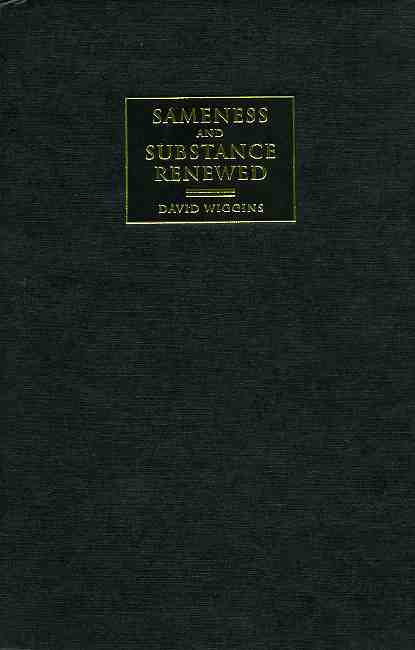【書名】Sameness and Substance Renewed
【著者】David Wiggins
【刊行】2001年
【出版】Cambridge University Press, Cambridge
【頁数】xvi+257 pp.
【定価】£38.52
【ISBN】0-521-45411-5 (hardcover)
【備考】初版は『Identity and the Spatio-Temporal Continuity』(1967年)/第2版は『Sameness and Substance』(1980年)

【目次】
Preface ix
Preamble, chiefly concerned with matters methodological and terminological
1 1. Aims and purposes 12. Formal properties of identity 4
3. Notions 5
4. Philosophical terminology: a manifesto 7
5. Sortal predicates and sortal concepts: and concepts versus conceptions 8
6. real and nominal 11
7. Necessary / contingent and a priori / a posteriori 12
8. Formal notations 14
9. The mode of combination involved in 'is the same donkey as' 15
10. Questions of priority 18
1. The absoluteness of sameness 21
1. A central question about identity; and rival answers given by defenders of the absoluteness of identity and the relativity of identity 212. Leibniz's Law and the difficulties of relative identity 24
3. Five ways for it to be false that a=[g]b 28
4. Possible examples of type-(4) relativity 34
5. Some zases that might be alleged to be of type-(5) 35
6. Discussion of type-(4) cases 36
7. Discussion of type-(5) cases and some attempted amendments of Leibniz's Law 43
8. A mathematical example supposedly of type-(5) 50
9. Conclusion concerning _R_, the Relativity of Identity 51
10. Absoluteness and sortal dependence jointly affirmed and formalized 53
2. Outline of a theory of individuation 55
1. Proposition _D_ and the rationale of the 'same what?' question 552. The charge of circularity, or of emptiness 58
3. The identity of indiscernibles 61
4. Proposition _D_ further explicated and amplified: and _D_(ii) as the proper development of _D_ 63
5. Existence and sortal predications 68
6. Further _D_ principles 69
7. Miscellaneous further principles; and a doubt about counting 74
3. Sortal concepts: and the characteristic activity or function or purpose of things falling under them 77
1. The sortal predicates of natural kinds 772. The other sortal predicates 86
3. Problems of artificial identity 91
4. Two approaches to the problem of artificial identity 95
5. Summary of conclusions to date: and a methodological remark 102
6. Transitions to Chapters Four and Five 105
4. Individuative essentialism 107
1. Independence from the explicitly modal of the foregoing theory of individuation 1072. Principles and maxims governing the derivation of a modest essentialism 108
3. The necessity of identity, and some asymmetrical necessities 114
4. Conceivability, theory and essence 118
5. Conceivability continued 121
6. Individuative essentialism and its consequences 123
7. That the idea of 'haecceitas' is as misbegotten as the word itself is unlovely 125
8. The essentialist 'must' and 'can' 126
9. Avoiding overspecificity, allowing vagueness 128
10. Other de re necessities, real or putative: a framework for further inquiry 130
11. The essences of artifacts and the matter of artefacts 133
12. One special kind of artefact: works of art and the essence of these 136
5. Conceptualism and realism 139
1. Anti-realist conceptualism and anti-conceptualist realism 1392. Four clarification 142
3. A conventionalist reconstruction of our modal convictions: a conceptualist anti-realist view of essence 144
4. A hypothesis concerning the sources of anti-essentialism 147
5. An exaggeration of conceptualism, deprecated and memded by some truisms: and reply to the anti-conceptualist realist begun 148
6. The perfect consonance of solar realism and sober conceptualism 151
7. The realist requirement restated, refurbished and satisfied 153
8. Concluding suggestions 155
6. Identity: absolute, determinate, and all or nothing, like no other relation but itself 157
1. Three contrasted views of singling out an object 1572. Back and fourth between the object and the thought of the object 159
3. Some putative examples of indeterminate objects 161
4. If object _a_ is the same as object _b_, then _a_ is determinately the same as _b_ 162
5. What, if anything, follows from such formal derivations? 163
6. Treatment of examples (a), (b), (c); #S#3 167
7. Sense and point; and sense as the work of mind 171
8. On the level of reference, things cannot be simply conceived into being or postulated into existence - not even material things with matter putatively ready at hand 173
9. Once again (one last time) the things to which simple identity sentences make a reference 176
10. More about the relation of identity 183
11. Might it ever be true to say that _a_ was almost _b_, that _a_ was almost numerically identical with _b_? 188
12. Conclusion 192
7. Personal identity 193
Part One1. An expeditions if precipitate answers to the question of personal identity 193
2. Doubts, and answers to doubts: subjects of consciousness 194
3. The Lockean conception; and Butler's criticisms of such conceptions 197
4. A neo-Lockean identity-condition 200
5. Butler's central insight 203
6. A neo-Lockean conception 205
7. Unfinished business 208
8. The theses to be argued in this chapter 211
9. Co-consciousness again, and quasi-memory 212
10. A second and third question about Parfit's definition of 'Q-remember' 214
11. Digression: An alternative method of definition, revealing by its inadaquacy the semantical point of the attribution of experimental memory 217
12. More about 'dependent in the right way' 222
Part Two
13. As it now appears, the state of the whole argument to date 225
14. Participation in the growth of knowledge 227
15. The penultimate problem and a verdict upon it, all leading in due course to a reassessment of the original Shoemaker case 231
16. Brown-Brownson reconsidered 232
17. One last variant - and the philosophical moral of same. Finally, human persons as artefacts? 236
Select Bibliography 245
Index of names of persons cited or mentioned 251
Index of contents (themes, theses, examples, etc.) 253